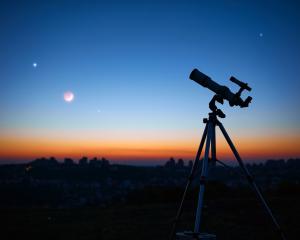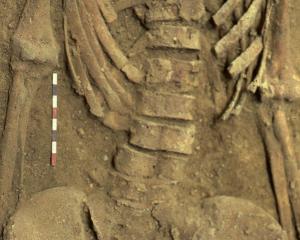Out of the blue, on a Saturday, earlier this year New Zealand’s Civil Aviation Authority received a surprise email.
“I was wondering if any unusual radar activity, capturing a large signature, was recorded over Upper Hutt, Trentham, on Friday, February 12, at about 2230 hours?" the emailer inquired.
Describing themselves as a retired policeman and private pilot, the person said they had seen "a very large object" in the night sky above the ranges separating Upper Hutt from Porirua.
"I am not a nutter and I had not been drinking.
"It went right over my suburb."
The emailer described the aircraft as "around a football field" in size.
It was, they said, a perfect equilateral triangle, black, with no lights.
"I have no idea what it was but it was impressive, large, fast and totally silent."
Unidentified flying objects (UFOs) are back in the news.
Not least because the Pentagon, headquarters to the United States Department of Defence, has been promising for months that at the end of June it would release a report summarising all it knows about UFOs.
Last weekend, the Pentagon’s Unidentified Aerial Phenomenon (UAP) Task Force dropped an unclassified version of that report in the lap of an expectant public. It confirmed what had been previously leaked: the task force investigation of more than 140 US military UFO sightings from the past two decades concluded there was no clear evidence of aliens.

It was not the history-making revelation some hoped for. For others, it gave too much respectability to the possibility of aliens.
That divide, like UFO sightings, goes much further back than the start of this millennium and reaches much further around the globe than the boundaries of US airspace.
Written reports of unnatural objects in New Zealand skies began in Balclutha, South Otago, in July, 1909, and quickly spread northwards.
On August 5, the Otago Daily Times ran a story headlined "Aerial Lights Cruising Over Otago Harbour".
The reporter had spoken to two people who said they saw the reappearance of a light that scores of people previously reported hovering over Logan Point.
"The thing came up the harbour, apparently only 20 or 30 yards above the water, with extraordinary rapidity, and then rose suddenly, swung to the left, and disappeared over the hills in the direction of Anderson's Bay," the article stated.
During July and August, strange lights and airships were reported as far north as Dargarville.
The country’s next significant flying saucer flap was in 1952, when 105 UFOs were reported. That included, on the night of December 6, more than 15 similar sightings from throughout the country. But 25 years later, those reports were revealed to be a hoax hatched by University of Otago students before they dispersed throughout the country at the end of the academic year.
The country’s best known UFO encounter was during two nights in December, 1978. Film footage shot on the second night made international headlines and is still unexplained.
The New Zealand Defence Force (NZDF) had begun keeping a UFO dossier in 1952. In 2010, it released a redacted version of that file — 2500 pages, in 12 volumes, representing almost 60 years of secret documents detailing eye-witness accounts and official reports of supposed sightings.
Today, Kiwi UFO sightings continue in a steady trickle. Suzanne Hansen, founder of Ufocus NZ, documents them on the organisation’s website. Since February’s Trentham sighting, the site lists three separate sightings in Hawke’s Bay on the evening of Saturday, April 24, and a sighting over Auckland at dusk on Sunday, May 16.
Belief and scepticism have run concurrent through the years.
In 1909, in the middle of the airship sightings, Dunedin’s Evening Star, ran a cartoon titled, "The Mystery — Hic — Sholved". It featured an inebriated man pointing at a lamp post and saying, "There'sh annuzer of those blessed airships — hic!"
Included in the NZDF UFO files is a letter from the Director of Civil Aviation written, in 1955, to an un-named man in Timaru who claimed he had "witnessed a flying saucer taking off from Levels airport on the evening of the 23rd of August, 1953".
The director, presumably with satirical satisfaction, replied, "The flying saucer observed by your nephew and yourself may have been carrying passengers for hire and reward, which would be contrary to the Civil Aviation Regulations, as the licence for this aerodrome does not include flying saucers in the categories of aircraft licensed for use.
"In the event that you witness any further unauthorised operations of this nature it would be appreciated if you could be more prompt in advising this Administration."
That incredulity continues today. The University of Auckland’s Professor Richard Easther, who studies the physics of the early universe, puts it succinctly. If aliens had the unimaginable technology, and went to the enormous effort needed, to visit Earth, "Why would they come here and then fly around in circles like some kind of boy-racer aliens?".
It all begs the question, unanswered by last week’s Pentagon report: is there intelligent alien life out there?
The considered answer, in short, is, almost certainly.
Last month, The Conversation, which produces research-based news and analysis, asked five Australian scientists — two astrobiologists, an astrophysicist, a planetary scientist and a space technologist — whether they thought aliens exist. Four out of five said, yes.
That is a profound change, compared with even 10 years ago.
What has made the difference is expanding knowledge of the cosmos.
Despite Prof Easther’s scepticism about UFO sightings, he says it is reasonable to expect that the right conditions for life are present elsewhere in the universe.
"That’s the Hitchhiker’s Guide to the Galaxy thing: an insignificant little planet orbiting a small yellow sun at the unfashionable end of a spiral arm of a galaxy," Prof Easther says.
"There is nothing, as far as we can tell, particularly remarkable about the circumstances in which we live."
And if life is going to emerge on more than one planet, now is a pretty good time for that to happen, he says.
This stage in the life of the universe offers the stability and raw materials for life to evolve and flourish wherever the right conditions exist.
"The atoms that make up our bodies have passed through stars ... likewise, the iron in our blood is produced in supernova explosions and returned to the cosmos.
"In that sense, you need a few billion years for that first generation of stars to be born and die, and the sun itself is four-and-a-half billion years old ... So it is true that life is more likely to ‘take’ now than it was 10 billion years ago."
Those "right conditions" appear much more plentiful than once believed, Prof Chris Smeenk says.
Prof Smeenk is director of the Rotman Institute of Philosophy, at Western University, Ontario, Canada.

Within the past decade, he says, astronomers’ observations have given us a much better estimate of the number of planets that could have earth-like conditions.
"And the number is large — recent estimates of about six billion within the Milky Way," Prof Smeenk says.
"Even if the development of life is a one-in-a-million occurrence on an Earth-like planet, there would be a lot of alien life in the Milky Way.
"I would say that the odds are very high that there is life with a similar level of intelligence."
If aliens have made it to our corner of the galaxy, there are a select group of sightings that are difficult to dismiss as potential evidence.
One was here in New Zealand, the 1978 Kaikoura Lights.
On the night of December 20, Air Traffic Controllers (ATC), pilots, and Royal New Zealand Air Force (RNZAF) staff all saw things they could not explain.
When recently contacted by The Mix, former ATC, John Cordy, now 88, recounted the events of that night.
Over a period of several hours, the Blenheim RNZAF staff saw lights in the sky, Cordy and fellow Wellington ATC saw the same objects on their radar and two pilots aloft in the area had visual contact with large amber-white, pulsating lights that moved at incredible speeds.
"They were objects, they were airborne and we didn’t know what they were," Cordy says.
"I’d love to know what they were."
Ten days later — news of the UFOs having already spread widely — Australian television journalist Quentin Fogarty (formerly of Dunedin) was aboard night flights between Blenheim and Christchurch. On the first flight, unidentified lights were seen by pilots and passengers, and tracked by radar in Wellington. A few minutes into the return flight, a large bright light appeared and tracked alongside the plane for 15 minutes.
The film footage went worldwide.
An official investigation gave a variety of explanations — squid boats, Venus or unburnt meteors. But they have been consistently dismissed by those who were on the planes, manned the radar and have examined the film.
Other verified UFO, from this millennium, were captured on video by US Navy fighter pilots in 2004 and 2015. They show fast-moving white oval objects about 15m long without wings or exhaust, that fly while at times simultaneously rotating on their axis. The videos, which had been verified as authentic by the US Navy, were leaked to the public in 2007 and 2017.
If aliens are out there, showing off to the world’s pilots, what does it matter? And does it matter if they aren’t? Put another way, what is the existential and cosmological significance of the existence or non-existence of aliens?
An academic paper published last week, in Nature, revealed that four suns with potentially habitable planets are currently close enough to receive radio waves from Earth. Have they heard us?
Some think entertaining the possibility of aliens shows a desire to believe in something "other" — a primitive urge we need to outgrow.
It is the sort of approach taken by freelance journalist Sarah Scoles in her book They are already here: UFO culture and why we see saucers. Scoles, who has investigated a variety of UFO phenomenon, urges people to be wary given what she says are humans’ deep-seated need to believe in something beyond themselves.
But others see it in reverse.
For Prof Smeenk, the high probability of intelligent alien life elsewhere in the universe means its absence would likely lead people to "other" conclusions.
"Non-existence would be much more striking, although I’m not sure how we would ever actually establish that," Prof Smeenk says.
"It would imply that the origin of life and the particular evolutionary trajectory on Earth were astonishingly improbable, and I expect would provide a lot of support for a new version of the Design Argument."
James Maclaurin focuses on the many ways, positive and negative, an encounter with aliens could change life on Earth.
Prof Maclaurin is a philosopher of science and is co-director of the Centre for Artificial Intelligence and Public Policy, at the University of Otago.
We are inclined to think many features of our culture and biology are inevitable in a highly intelligent evolved species, he says.
That assumption could be shaken to its core if we came face-to-whatever-counts-for-a-face with an intelligent species that has quite different expressions of art, science, ethics, sensory modalities, emotions or consciousness.
"Doubtless, some people might find very challenging the idea of aliens that are smarter than us," Prof Maclaurin says.
"Some people would likely be excited about the prospect of learning from super-intelligent aliens. Others would, perhaps sensibly, fear colonisation."
Even if aliens are, at this moment, standing on potentially habitable planets circling the red dwarf star Ross 128, Teegarden's Star and the TRAPPIST-1 system listening to us, what are the odds we will come into contact with each other?
Not high, Prof Easther suggests.
Humanity might have disappeared before those aliens could visit us, he says.
"It is conceivable that we are one of the few technologically advanced species in the universe.
“Maybe the time in which intelligent life exists on a planet is quite short.”
And neither we, nor they, might ever develop the technology needed for interstellar travel.
"It could very well be that there is no easy way to do that.
"As far as we can tell, there are very few loopholes in the laws of physics ... It may be that the universe is structured in such a way that would prevent us from ever building things such as warp drives to let us travel faster than the speed of light."
The Weekend Mix confirmed with the CAA that it received an email from someone saying they had seen a football field-sized, triangular object fly over Trentham at night four and a half months ago.
Airways, which provides air traffic control in New Zealand, says it could be another month before it is able to check back through its radar record for that night.
Citing privacy concerns, the CAA would not contact the person who reported the sighting to ask if they would be happy to contact The Weekend Mix.
All there is to go on, on the Ufocus NZ website, is the unverified email exchange between the claimed retired police officer and pilot and the CAA.
"I am aware that the Wings over Wairarapa airshow are organising a fly-by of a US Air force Boeing B-52 Stratofortress for the 27th February," someone from CAA aeronautical services writes.
"If this fits your description perhaps it was a trial run?”
“No, definitely wasn’t a B52,"the Trentham spotter replies.
"It was massive ... I don’t believe in flying saucer rubbish but I have to admit I’m struggling with this.”












